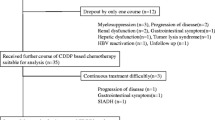Summary
It has been reported that hypertonic saline provides protection against the renal toxicity of cisplatin (CDDP). We therefore evaluated its influence on the plasma and urinary pharmacokinetics of ultrafilterable platinum and kidney function as estimated by creatinine, inulin and PAH clearance. We undertook a randomized trial including two groups of ten patients receiving 100 mg/m2 CDDP in isotonic (group 1) or hypertonic saline (group 2) by a 20-min infusion. The hydration consisted of dextrose in group 1 and isotonic saline in group 2. Maximal concentration (Cmax), protein binding and cumulative urinary excretion were significantly higher in the dextrose group. Urinary flow decreased in this group but not in the other one. Inulin clearance was higher in the dextrose group than in the saline group andP-aminohippuric acid (PAH) clearance was not significantly different in these groups of patients. Hyponatremia was observed in the dextrose group. These results suggest that hypertonic saline infusion and saline hydration may enhance the diffusion of CDDP into tissues, lowering Cmax and renal excretion of platinum. The reduction of protein binding may indicate a diminution of aquation of CDDP in plasma. Our results suggest that the infusion of CDDP in hypertonic saline with salt hydration could exert a protective effect on the kidney. Moreover, there is a lessening of the risk of cellular hyperhydration. However, the better influence of dextrose hydration on glomerular filtration leads us to recommend a combination of the two methods of hydration for better tolerance and efficacy.
Similar content being viewed by others
References
Belt RJ, Himmelstein KJ, Patton TF, Bannister SJ, Sterson LA, Repta AJ (1979) Pharmacokinetics of non protein-bound platinum species following administration ofcis-diamminedichloroplatinum(II). Cancer Treat Rep 63: 1515
Conger JD, Falk SA (1986) Glomerular and tubular dynamics in mercuric chloride-induced acute renal failure. J Lab Clin Med 107: 281
Corden BJ, Fine RL, Ozols RF, Collins JM (1985) Clinical pharmacology of high dose cisplatin. Cancer Chemother Pharmacol 14: 38
Daley-Yates PT, McBrien DC (1985) A study of the protective effect of chloride salts on cisplatin nephrotoxicity. Biochem Pharmacol 34: 2363
Daugaard G, Abilgaard U, Holstein-Rathlou NH, Leyssac PP, Amtorp O, Dikhoff TG (1986) Acute effects of cisplatin on renal hemodynamics and tubular function in dog kidneys. Renal Physiol 9: 308
Dumas M, d’Athis P, Gislain C de, Escousse A, Guerrin J, Autissier N (1985) Model independent pharmacokinetic study ofcis-diamminedichloroplatinum(II). Clin Pharmacol Ther Toxicol 23: 430
Dumas M, Gislain C de, d’Athis P, Chadoint-Noudeau V, Escouse A, Guerrin J, Autissier N (1989) Evaluation of the effect of furosemide on ultrafilterable platinum kinetics in patients treated withcis-diamminedichloroplatinum. Cancer Chemother Pharmacol 23: 37
Earhart RH, Martin PA, Tutsch KD, Erlück E, Wheeler RH, Bull FE (1983) Improvement in the therapeutic index of cisplatin (NSC 119875) by pharmacology induced chloruresis in the rat. Cancer Res 43: 1187
Goren MP, Forastiere AA, Wright RK, Horowitz ME, Dodge RK, Kamen BA, Viar RJ, Pratt CB (1987) Carboplatin (CBDCA), iproplatin) (CHIP) and high dose cisplatin in hypertonic saline evaluated for tubular nephrotoxicity. Cancer Chemother Pharmacol 19: 57
Greene RF, Chatterji DC, Hiranaka PK, Gallelli JF (1979) Stability of cisplatin in aqueous solution. Am J Hosp Pharm 36: 38
Gullo JJ, Litterst CL, Maguire PJ, Sikik BI, Hoth DF, Wooley PV (1980) Pharmacokinetics and protein binding ofcis-diamminedichloroplatinum(II) administered as a one hour or a twenty hour infusion. Cancer Chemother Pharmacol 5: 21
Hamburger J, Rycckevert, Duizend, Argant (1948) Microdosage de l’acide para aminohippurique dans le sang et les urines. Ann Biol Clin 6: 358
Heidemann HT, Gerkens JF, Jackson EK, Branch RA (1985) Attenuation of cisplatinum-induced nephrotoxicity in the rat by high salt diet, furosemide and acetazolamide. Arch Pharmacol 329: 201
Heyrouski A (1956) A new method for the determination of inulin in plasma and urine. Clin Chim Acta 1: 470
Kelsen DP, Alcock N, Young CW (1985) Cisplatin nephrotoxicity. Correlation with plasma concentration. Am J Clin Oncol 8: 77
Kirshbaum BB, Spinkle FM, Oken DE (1980) Renal function and mercury level in rats with mercuric chloride nephrotoxicity. Nephron 26: 28
Levi F, Hureshky WJM, Borch RF, Pleasant ME, Kennedy BJ, Halberg F (1982) Cisplatin urinary pharmacokinetics and nephrotoxicity: a commun circadian mechanism. Cancer Treat Rep 66: 1933
Litterst CL (1981) Alterations in the toxicity ofcis-diamminedichloroplatinum(II) and in tissue localization of platinum as a function of NaCl concentration in the vehicle of administration. Toxicol Appl Pharmacol 61: 99
Nanji AA, Stewart DJ, Mikhael NZ (1986) Hyperuricemia and hypoalbuminemia predispose to cisplatin-induced nephrotoxicity. Cancer Chemother Pharmacol 17: 274
Offerman JJG, Meijer S, Sleijfer DT, Mulder NH, Donker AJM, Schraffordt Koops H, Hem GK van der (1984) Acute effects ofcis-diamminedichloroplatinum (CDDP) on renal function. Cancer Chemother Pharmacol 12: 36
Ostrow S, Egorin MJ, Hahn D, Markus S, Aisner J, Chang P, Leroy A, Bachur NR, Wiernik PH (1981) High dose cisplatin therapy using mannitol versus furosemide diuresis: comparative pharmacokinetics and toxicity. Cancer Treat Rep 65: 73
Ozols RF, Corden BJ, Jacob J, Wesley MN, Ostchega Y, Young RC (1984) High-dose cisplatin in hypertonic saline. Ann Intern Med 100: 19
Reece PA, Stafford I, Davy M, Freeman S (1987) Disposition of unchanged cisplatin in patients with ovarian cancer. Clin Pharmacol Ther 42: 320
Sarfistein R, Miller P, Guttenplan JB (1984) Uptake and metabolism of cisplatin by rat kidney. Kidney Int 25: 753
Winston JA, Safirstein R (1985) Reduced renal blood flow in early cisplatin-induced acute renal failure in the rat. Am J Physiol 249: F490
World Health Organization (1979) Handbook for reporting results of cancer treatment. Offset publication 10: 48. WHO, Geneva
Author information
Authors and Affiliations
Rights and permissions
About this article
Cite this article
Dumas, M., de Gislain, C., d’Athis, P. et al. Influence of hydration on ultrafilterable platinum kinetics and kidney function in patients treated withcis-diamminedichloroplatinum(II). Cancer Chemother Pharmacol 26, 278–282 (1990). https://doi.org/10.1007/BF02897230
Received:
Accepted:
Issue Date:
DOI: https://doi.org/10.1007/BF02897230




